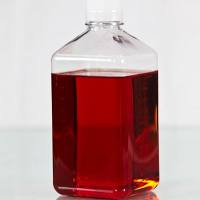Determination of Protein Contacts by Chemical Cross‐Linking With EDC and Mass Spectrometry
互联网
- Abstract
- Table of Contents
- Materials
- Figures
- Literature Cited
Abstract
This unit describes a method for analyzing protein complexes by chemically cross?linking closely positioned amino acids. The cross?linked products are isolated by SDS?PAGE and the bands of interest are excised. Proteins in the excised gel piece are digested with trypsin and the resulting peptides recovered. Chemically bonded peptides are distinct from the multitude of unmodified single peptides by the presence of two carboxy?terminal ends. The protocol also describes incorporation of 18 O at the carboxy?terminal ends and purification and preparation of the peptide mixture for mass spectroscopy.
Keywords: protein contacts; cross?links; isotopic exchange; mass spectrometry
Table of Contents
- Reagents and Solutions
- Commentary
- Literature Cited
- Figures
Materials
Basic Protocol 1:
Materials
|
Figures
-
Figure 19.16.1 The mechanism of condensation (cross‐linking) reaction between a protein side chain carboxyl (I) and amine (II) group. (A ) Reaction with EDC alone. (B ) NHS forms a more stable active ester (V) and increases the yield of the isopeptide (cross‐link) bond (IV). View Image -
Figure 19.16.2 Portion of a MALDI‐TOF spectrum displaying the isotopic distribution of a cross‐linked H2 16 O/H2 18 O‐double‐labeled peptide. View Image
Videos
Literature Cited
| Back, J.W., Notenboom, V., de Koning, L.J., Muijsers, A.O., Sixma, T.K., de Koster, C.G., and de Jong, L. 2002. Identification of cross‐linked peptides for protein interaction studies using mass spectrometry and 18O labeling. Anal. Chem. 74:4417‐4422. | |
| DeTar, D.F. and Silverstein, R. 1966. Reactions of carbodiimides. II. The reactions of dicyclohexylcarbodiimide with carboxylic acids in the presence of amines and phenols. J. Am. Chem. Soc. 88:1013‐1019. | |
| Schnolzer, M., Jedrzejewski, P., and Lehmann, W.D. 1996. Protease‐catalyzed incorporation of 18O into peptide fragments and its application for protein sequencing by electrospray and matrix assisted laser desorption/ionization mass spectrometry. Electrophoresis 17:945‐953. | |
| Sehgal, D. and Vijay, I.K. 1994. A method for the high‐efficiency of water‐soluble carbodiimide‐mediated amidation. Anal. Biochem. 218:87‐91. | |
| Sinz, A. 2003. Chemical cross‐linking and mass spectrometry for mapping three‐dimensional structures of proteins and protein complexes. J. Mass Spectrom. 38:1225‐37. | |
| Staros, J.V., Wright, R.W., and Swingle, D.M. 1986. Enhancement by N‐hydroxysulfosuccinimide of water‐soluble carbodiimide‐mediated coupling reactions. Anal. Biochem. 156:220‐222. | |
| Trakselis, M.A., Alley, S.C., and Ishmael, F.T. 2005. Identification and mapping of protein‐protein interactions by a combination of cross‐linking, cleavage, and proteomics. Bioconjugate Chem. 16:741‐751. | |
| Yao, X., Afonso, C., and Fenselau, C. 2003. Dissection of proteolytic 18O labeling: endoprotease catalyzed 16O‐to‐18O exchange of truncated peptide substrates. J. Proteome Res. 2:147‐152. | |
| Key References | |
| Sinz, 2003. See above. | |
| An extensive review of cross‐linkers, types of cross‐links and methods of MS analysis. | |
| Trakselis et al., 2005. See above. | |
| Recent advances and current experimental techniques for identifying protein contacts and networks by mass spectrometry. | |
| Internet Resources | |
| http://www.gpmaw.com | |
| GPMAW (General Protein/Mass Analysis for Windows). Software with many useful features for handling and analyzing protein and peptide sequences. | |
| http://www.piercenet.com | |
| The company offers a wide choice of cross‐linking reagents with varying spacer lengths and reactive towards different amino acid side chains. |









